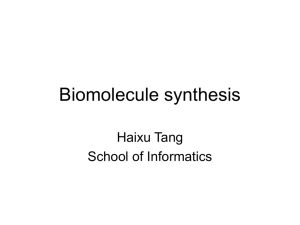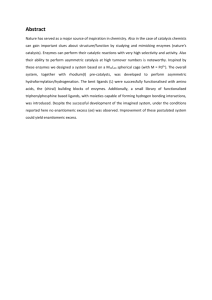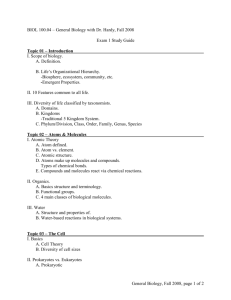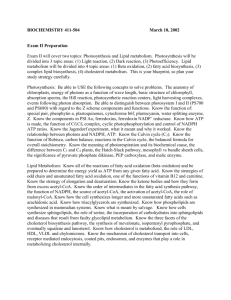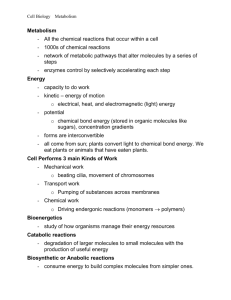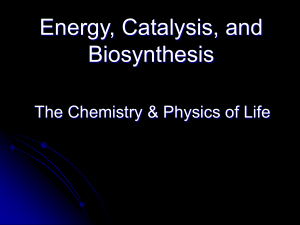Chapter 3 Energy, Catalysis, and Biosynthesis
advertisement
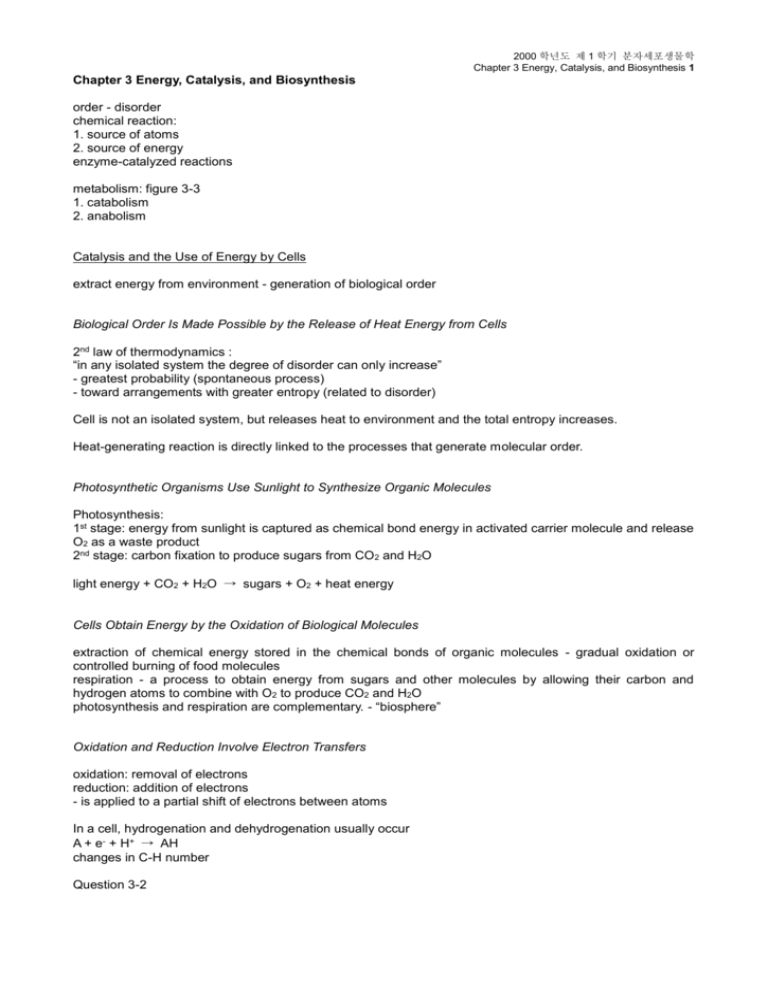
2000 학년도 제 1 학기 분자세포생물학 Chapter 3 Energy, Catalysis, and Biosynthesis 1 Chapter 3 Energy, Catalysis, and Biosynthesis order - disorder chemical reaction: 1. source of atoms 2. source of energy enzyme-catalyzed reactions metabolism: figure 3-3 1. catabolism 2. anabolism Catalysis and the Use of Energy by Cells extract energy from environment - generation of biological order Biological Order Is Made Possible by the Release of Heat Energy from Cells 2nd law of thermodynamics : “in any isolated system the degree of disorder can only increase” - greatest probability (spontaneous process) - toward arrangements with greater entropy (related to disorder) Cell is not an isolated system, but releases heat to environment and the total entropy increases. Heat-generating reaction is directly linked to the processes that generate molecular order. Photosynthetic Organisms Use Sunlight to Synthesize Organic Molecules Photosynthesis: 1st stage: energy from sunlight is captured as chemical bond energy in activated carrier molecule and release O2 as a waste product 2nd stage: carbon fixation to produce sugars from CO2 and H2O light energy + CO2 + H2O → sugars + O2 + heat energy Cells Obtain Energy by the Oxidation of Biological Molecules extraction of chemical energy stored in the chemical bonds of organic molecules - gradual oxidation or controlled burning of food molecules respiration - a process to obtain energy from sugars and other molecules by allowing their carbon and hydrogen atoms to combine with O2 to produce CO2 and H2O photosynthesis and respiration are complementary. - “biosphere” Oxidation and Reduction Involve Electron Transfers oxidation: removal of electrons reduction: addition of electrons - is applied to a partial shift of electrons between atoms In a cell, hydrogenation and dehydrogenation usually occur A + e- + H+ → AH changes in C-H number Question 3-2 2000 학년도 제 1 학기 분자세포생물학 Chapter 3 Energy, Catalysis, and Biosynthesis 2 Enzymes Lower the Barriers That Block Chemical Reactions paper + O2 → smoke + ashes + heat + CO2 + H2O 1. irreversible reaction: dissipation of heat and disorderedness of paper molecule 2. a loss of free energy (a loss of orderliness) 3. energetically favorable activation energy - a kick over an energy barrier enzymes in a living cell: *substrate 1. lower the activation energy (figure 3-13) - by factor of 1014 ! 2. selective process (active site) - specific pathway (figure 3-14) - non-covalent bond : ionic, van der Waals, hydrogen How Enzymes Find Their Substrates: The Importance of Rapid Diffusion typical reaction rate: thousand substrates per second (binding and catalysis altogether) “rapid” diffusion collision between enzyme and substrate enzyme-substrate complex - many weak bonds stronger than thermal energy (~ 0.6kcal/mole) (specificity) The Free-Energy Change for a Reaction Determines Whether It Can Occur nature favors downhill not uphill. In cells, uphill reaction must occur - through coupling “energetically favorable” change in free energy (G) : the amount of disorder created in the universe the sign of G The Concentration of Reactants Influences G (figure 3-20) equation 1. 2. G° : standard free-energy change - intrinsic characters of the reacting molecules concentration dependency chemical equilibrium - G = 0 relationship between G° and equilibrium constant enzymes cannot change the equilibrium point for reactions (figure 3-21) (question 3-4) For Sequential Reactions, G° Values Are Additive coupling between unfavorable and favorable chemical reactions (figure 3-22): “siphon” the overall fee-energy change for a metabolic pathway is the sum of free-energy changes component steps in each of its Activated Carrier Molecules and Biosynthesis the energy released by the oxidation of food is stored as chemical bond energy in activated carrier molecule 1. energy-rich covalent bonds : easily exchangeable (chemical group or high-energy electron) - dual role as a source of both energy and chemical groups in biosynthesis 2. rapid diffusion from energy generation sites to energy-requiring sites (biosynthesis) Table 3-2 * coenzyme, “hard-cash” 2000 학년도 제 1 학기 분자세포생물학 Chapter 3 Energy, Catalysis, and Biosynthesis 3 The Formation of an Activated Carrier Is Coupled to an Energetically Favorable Reaction figure 3-24 1. falling rocks - oxidation of food molecules 2. paddle wheel - enzymes 3. water bucket - activated carrier molecules 4. heat - heat 50% efficiency in cells compared to 20% in modern car engines ATP Is the Most Widely Used Activated Carrier Molecule ATP (adenosine 5’-triphosphate) → ADP (adenine 5’-diphosphate) + Pi 1. ΔG = 11 ~ 13 kcal/mole (repulsion between negative charges and stabilization in water) (question 3-7) 2. coupled to many unfavorable reactions 3. phosphorylation (kinase) Energy Stored in ATP Is Often Harnessed to Join Two Molecules Together A-H + B-OH → A-B + H2O (energetically unfavorable) 1. B-OH + ATP → B-O-PO3 + ATP 2. A-H + B-O-PO3 → A-B +Pi Net result: B-OH + ATP + A-H → A-B + ADP + Pi e.g. glutamic acid → glutamine *high-energy intermediate NADH and NADPH Are Important Electron Carriers NAD+ (nicotineamide adenine dinucleotide) + H- (hydride ion) → NADH (reduced NAD) NADP+ (nicotineamide adenine dinucleotide phosphate) + H- (hydride ion) → NADPH (reduced NADP) * hydride ion (proton plus two electrons) involved in many biosynthetic reactions location of phosphate in NADPH 1. too far to be involved in electron transfer 2. differences in shape - substrates to different sets of enzymes NADPH - anabolic reactions NADH - catabolic reactions NAD+/NADH - high : acts as an oxidizing agent NADP+/NADPH - low : acts as a reducing agent There Are Many Other Activated Carrier Molecules in Cells Table 3-2 : different species according to energy-rich covalent groups “handle” - recognition by specific enzymes figure 3-30 figure 3-31 (carboxylated biotin) The Synthesis of Biological Polymers Requires an Energy Input macromolecules - from subunits (monomers) 1. condensation - unfavorable 2. hydrolysis -favorable (figure 3-32) figure 3-34 : an alternative route for the hydrolysis of ATP (up to 26kcal/mole) 2000 학년도 제 1 학기 분자세포생물학 Chapter 3 Energy, Catalysis, and Biosynthesis 4
